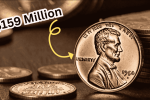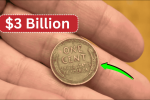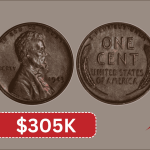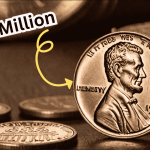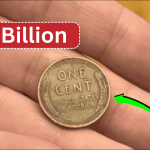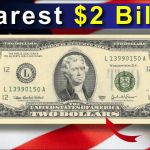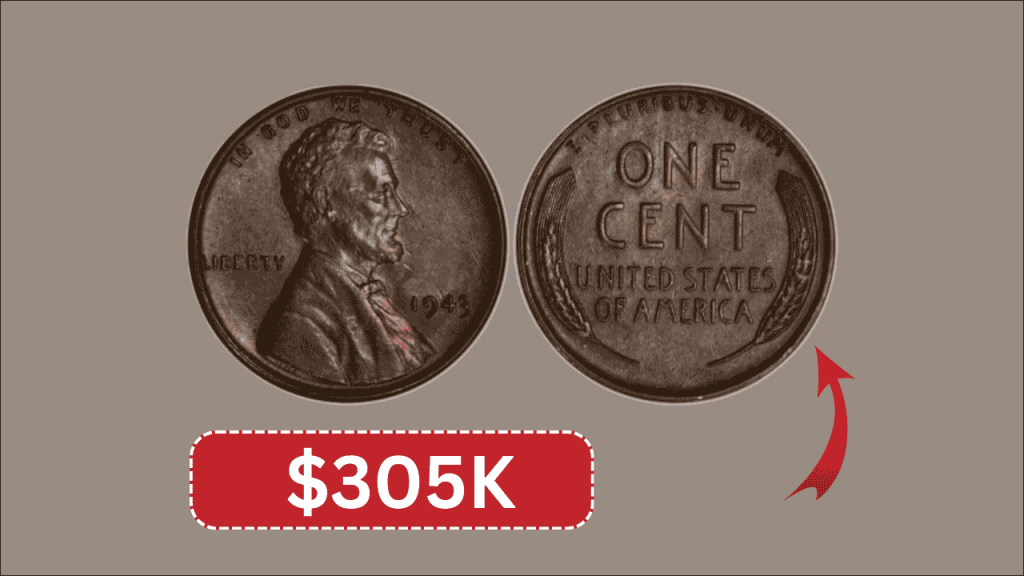
In the world of numismatics, few coins capture the imagination quite like the Lincoln Wheat Penny. While most copper pennies are worth exactly one cent, certain rare specimens command extraordinary prices at auction. Among these, the 1943 copper penny stands out as one of the most valuable American coins ever produced, with exceptional examples selling for up to $305,000. Even more fascinating is the possibility that some of these extremely valuable pennies may still be circulating undetected in everyday pocket change or sitting forgotten in old coin jars across America.
The History of the Lincoln Wheat Penny
The Lincoln cent, commonly called the Lincoln penny, was first issued by the United States Mint in 1909 to commemorate the 100th anniversary of Abraham Lincoln’s birth. Designed by sculptor Victor David Brenner, this coin represented a significant departure from previous American coinage, which had traditionally featured symbolic representations rather than actual historical figures.
| Year | Milestone | Description |
|---|---|---|
| 1909 | First Issue | Lincoln Wheat Penny introduced to commemorate Lincoln’s 100th birthday |
| 1909-1958 | Wheat Design Era | Reverse featured two wheat stalks (hence “Wheat Penny”) |
| 1943 | Steel Pennies | Most pennies made from zinc-coated steel due to WWII copper shortage |
| 1944 | Return to Copper | Pennies returned to copper composition (95% copper, 5% tin and zinc) |
| 1959 | Design Change | Wheat design replaced with Lincoln Memorial |
| 1982 | Composition Change | Switched to copper-plated zinc (97.5% zinc, 2.5% copper) |
| 2009 | Bicentennial | Four special reverse designs celebrating Lincoln’s life |
| 2010-Present | Shield Design | Current design features Union Shield on reverse |
During its nearly five-decade production run from 1909 to 1958, the Lincoln Wheat Penny became one of America’s most recognized and collected coins. The design featured Abraham Lincoln’s profile on the obverse (front) and two stalks of wheat framing the words “ONE CENT” and “UNITED STATES OF AMERICA” on the reverse, giving the coin its distinctive “Wheat Penny” nickname.
You can learn more about the history and evolution of the Lincoln cent on the U.S. Mint’s official website.
The $305K Penny: The 1943 Copper Cent
The most valuable Lincoln Wheat Penny—the one that can reach values of $305,000 or more in pristine condition—is the 1943 copper cent. What makes this particular penny so extraordinary is not the design but the material from which it was made.
The Wartime Connection
In 1943, the United States was deeply engaged in World War II, and copper was designated as a strategic metal vital for the war effort. The U.S. Mint responded by switching penny production from the traditional copper alloy to zinc-coated steel for that year only. These 1943 “steel pennies” have a distinctive silvery appearance and are magnetic due to their steel content.
However, a very small number of copper planchets (coin blanks) from 1942 remained in the presses and were accidentally struck with 1943 dies, creating the exceedingly rare 1943 copper pennies. The U.S. Mint maintains information about these special pennies on their news and information page.
Rarity and Distribution
| Mint Location | Estimated Number of 1943 Copper Pennies | Current Known Examples |
|---|---|---|
| Philadelphia (no mint mark) | 10-15 | Approximately 15-20 |
| San Francisco (S) | 5-6 | 5-6 confirmed |
| Denver (D) | 1-2 | Only 1 confirmed |
| Total | 16-23 | 20-30 maximum |
The extreme rarity of these coins, especially those from the Denver and San Francisco mints, explains their extraordinary value to collectors. The single known authentic 1943-D (Denver) copper cent sold for $840,000 at a Heritage auction in 2021, making it one of the most valuable small denomination U.S. coins ever sold.
Other Valuable Lincoln Wheat Pennies
While the 1943 copper cent is the crown jewel of Lincoln Wheat Penny collecting, several other dates and varieties command impressive prices:
| Year/Variety | Special Characteristics | Estimated Value (Uncirculated) |
|---|---|---|
| 1944 Steel | Accidental use of leftover steel planchets | $75,000 – $125,000 |
| 1909-S VDB | First year, San Francisco mint, designer’s initials | $50,000 – $150,000 |
| 1955 Doubled Die | Major doubling error on obverse | $25,000 – $60,000 |
| 1922 No D | Denver mint mark missing | $20,000 – $50,000 |
| 1914-D | Low mintage from Denver | $35,000 – $75,000 |
| 1931-S | Second lowest mintage in series | $5,000 – $15,000 |
Visit the U.S. Mint’s Coin Programs page to learn more about Lincoln cents and other U.S. circulating coins.
How to Identify Valuable Lincoln Wheat Pennies
Could you have a $305,000 penny in your possession? Here’s how to check:
Identifying the 1943 Copper Cent
- Check the date: Look for “1943” on the obverse (front) under Lincoln’s bust.
- Test with a magnet: A regular 1943 steel penny will stick to a magnet, while the rare copper penny will not. This is the simplest test to start with.
- Verify the weight: A genuine 1943 copper cent weighs approximately 3.11 grams, while the common steel cent weighs about 2.7 grams.
- Examine the color: Even with toning or darkening from age, a genuine copper penny will have a different color than the zinc-coated steel versions.
- Look for counterfeits: Be aware that many fake 1943 copper pennies exist. Common counterfeits include:
- Copper-plated 1943 steel cents (these will still be magnetic)
- Altered 1948 pennies with the “8” modified to look like a “3”
Tools for Authentication
For potentially valuable coins, professional authentication is essential. Major third-party grading services include:
- Professional Coin Grading Service (PCGS)
- Numismatic Guaranty Corporation (NGC)
- American Numismatic Association Certification Service (ANACS)
These organizations can verify authenticity, assess condition, and provide a protective holder that enhances a coin’s marketability.
Why Valuable Pennies Might Still Be in Circulation
Despite their extraordinary value, there are several reasons why rare pennies might still be found in circulation:
- Lack of awareness: Most people don’t examine their change carefully or know what makes certain pennies valuable.
- Mistaken identity: The 1943 steel cents are often confused with dimes due to their silvery appearance, so 1943 copper cents might be overlooked as ordinary pennies.
- Collection dispersal: When collectors pass away, their collections are sometimes spent by uninformed heirs.
- Bank rolls: Unsearched penny rolls from banks occasionally yield surprising finds.
Recent Discoveries
The possibility of finding valuable wheat pennies isn’t just theoretical—there are documented cases of recent discoveries:
| Year | Discovery | Value | Circumstances |
|---|---|---|---|
| 2019 | 1943 Copper Cent | $204,000 | Found in a high school cafeteria in the 1940s |
| 2018 | 1943-S Copper Cent | $168,000 | Discovered in a collection inherited from father |
| 2012 | 1909-S VDB | $72,500 | Found in a roll of pennies from a bank |
| 2014 | 1944-D Steel | $115,000 | Discovered in a jar of coins at estate sale |
These documented finds reinforce the exciting possibility that more valuable wheat pennies remain to be discovered in everyday places.
How to Search for Valuable Pennies
If you’re inspired to hunt for these numismatic treasures, here are some recommended approaches:
Sources for Searching
- Coin roll hunting: Purchase rolls of pennies from banks and carefully examine each one.
- Inherited collections: Examine any coin collections passed down in your family.
- Estate sales and flea markets: Look for old coin jars or collections being sold by non-collectors.
- Coin star rejection trays: Check the rejection trays of coin counting machines, which often contain wheat pennies.
What to Look For
Beyond the ultra-rare 1943 copper cent, keep an eye out for:
- Any wheat penny dated before 1940
- Mint marks “D” or “S” (located under the date)
- Visible errors or doubling
- Unusual coloration or weight
- Extremely well-preserved specimens
The U.S. Mint’s Kids website offers educational resources about coin collecting that can help beginners learn the basics of identifying different coins.
Preservation Tips for Collectors
If you find or already own wheat pennies, proper handling and storage are essential to preserve their value:
- Handle by edges: Never touch the faces of the coin with your fingers.
- Use proper storage: Store in acid-free holders, not PVC flips which can damage coins over time.
- Avoid cleaning: Never clean old coins, as this can significantly reduce their value.
- Control environment: Store in a cool, dry place away from temperature fluctuations.
- Document provenance: Keep records of when and where coins were found or purchased.
The Investment Aspect
Rare Lincoln Wheat Pennies have shown impressive appreciation over time:
| Coin | Value in 1975 | Value in 2000 | Value in 2025 | Growth Rate |
|---|---|---|---|---|
| 1943 Copper | $10,000 | $85,000 | $305,000+ | 3,050% |
| 1909-S VDB | $550 | $12,000 | $50,000+ | 9,090% |
| 1955 Doubled Die | $825 | $10,000 | $25,000+ | 3,030% |
While past performance doesn’t guarantee future results, rare coins have historically provided both enjoyment and investment potential for collectors.
Conclusion
The $305,000 Lincoln Wheat Penny represents a fascinating intersection of history, rarity, and chance. While finding such a valuable coin in circulation is admittedly a long shot, it’s not impossible. The thrill of the hunt and the knowledge gained along the way make collecting wheat pennies a rewarding hobby regardless of whether you strike it rich.
Every wheat penny tells a story—about American history, the evolution of our currency, and the economic forces that shaped production decisions. As you examine your change or sort through old coin jars, remember that you’re not just looking for valuable coins; you’re connecting with a tangible piece of American history.
Who knows? The next time you receive change or clean out an old drawer, you might just find a small copper disc worth a fortune. As the saying goes in the collecting world, “It’s still out there.”
Frequently Asked Questions
How can I tell if my 1943 penny is the valuable copper version?
The easiest test is to use a magnet – if the penny sticks, it’s the common steel version; if not, it might be the rare copper cent worth up to $305,000.
Are wheat pennies still in circulation?
Yes, though increasingly rare, Lincoln Wheat Pennies (1909-1958) can still occasionally be found in circulation, particularly in older collections and coin jars.
Where can I get my potentially valuable penny authenticated?
Professional authentication services like PCGS, NGC, and ANACS can verify authenticity and grade condition, which is essential for potentially valuable coins.
